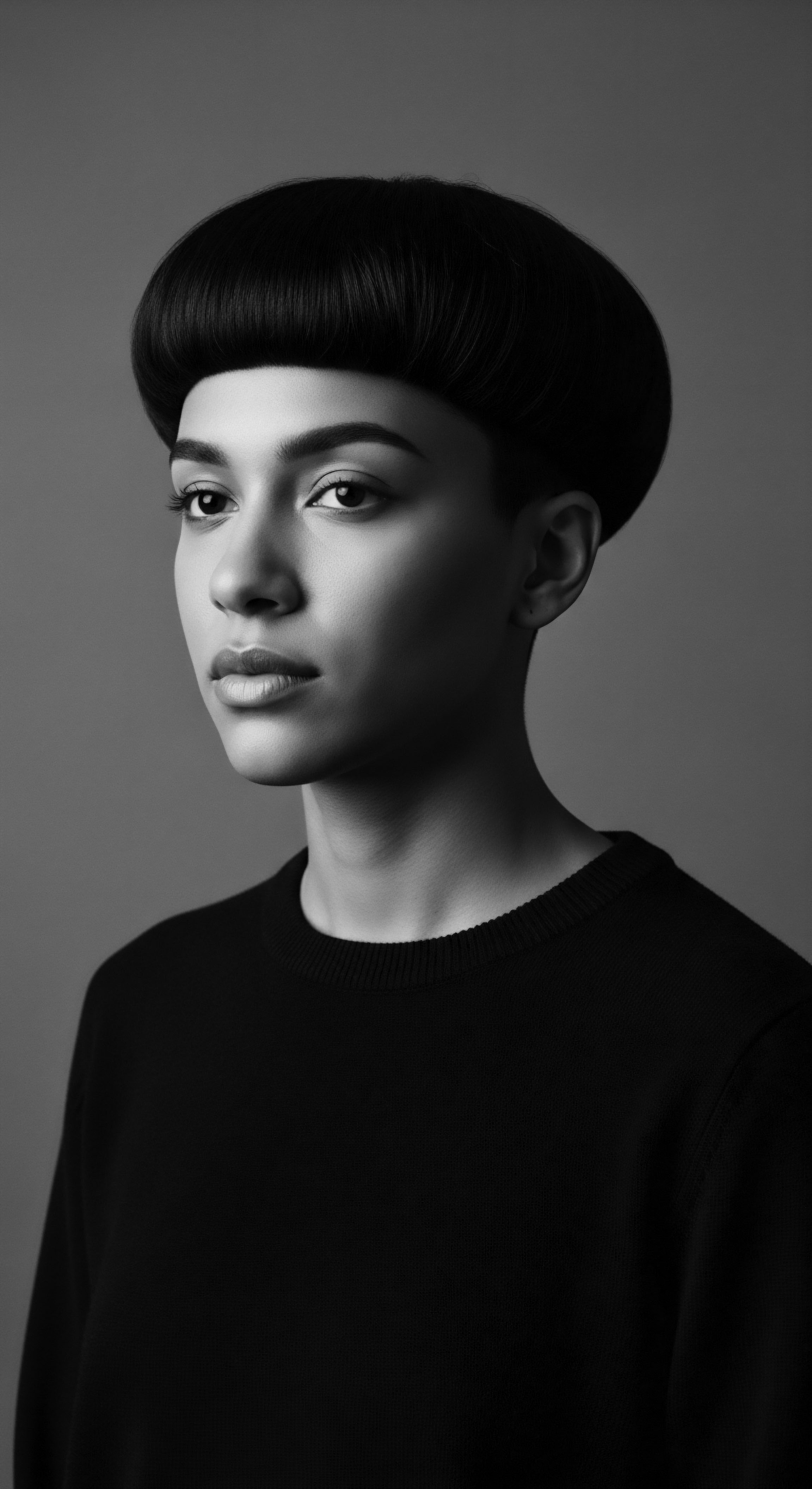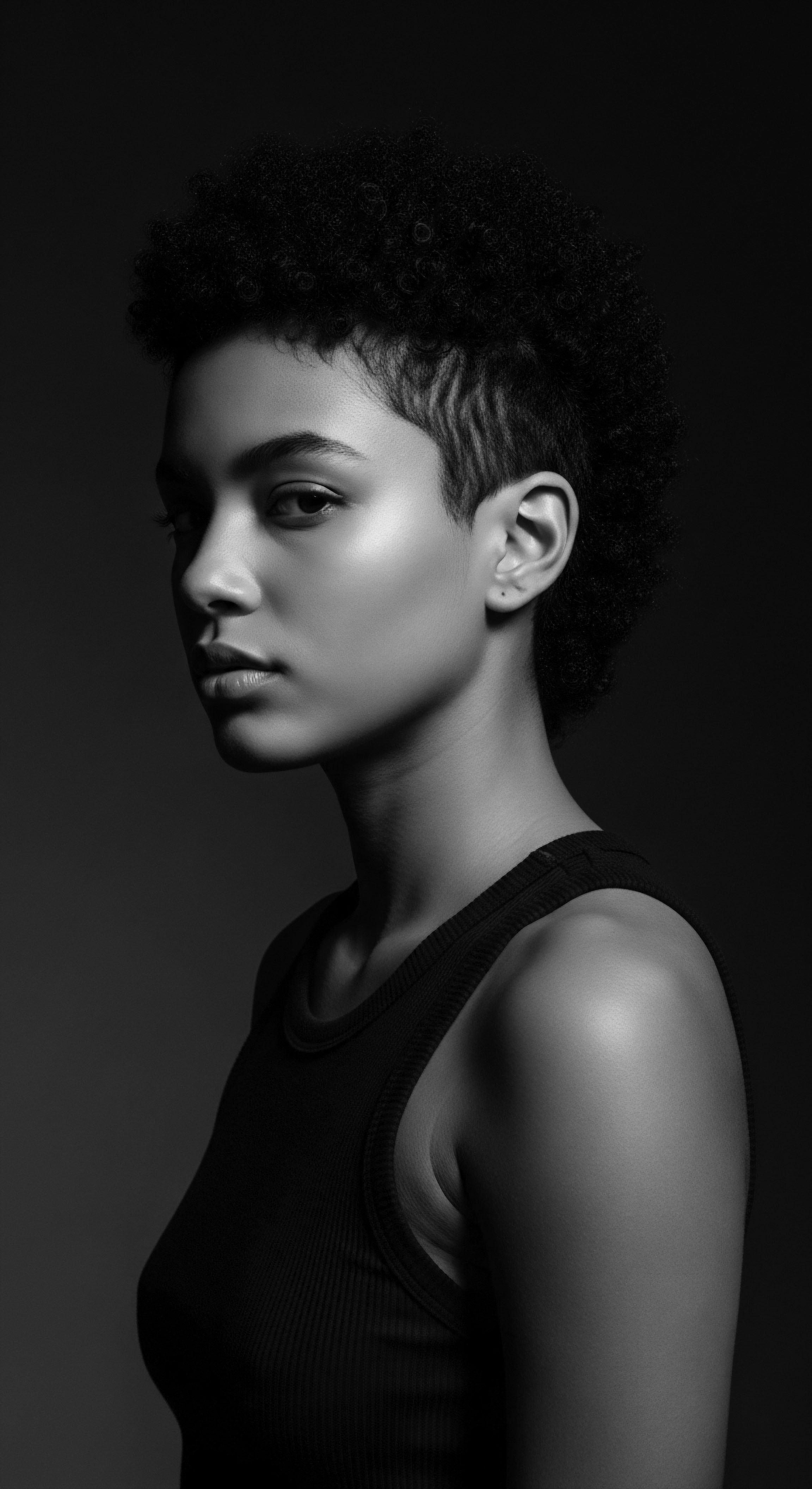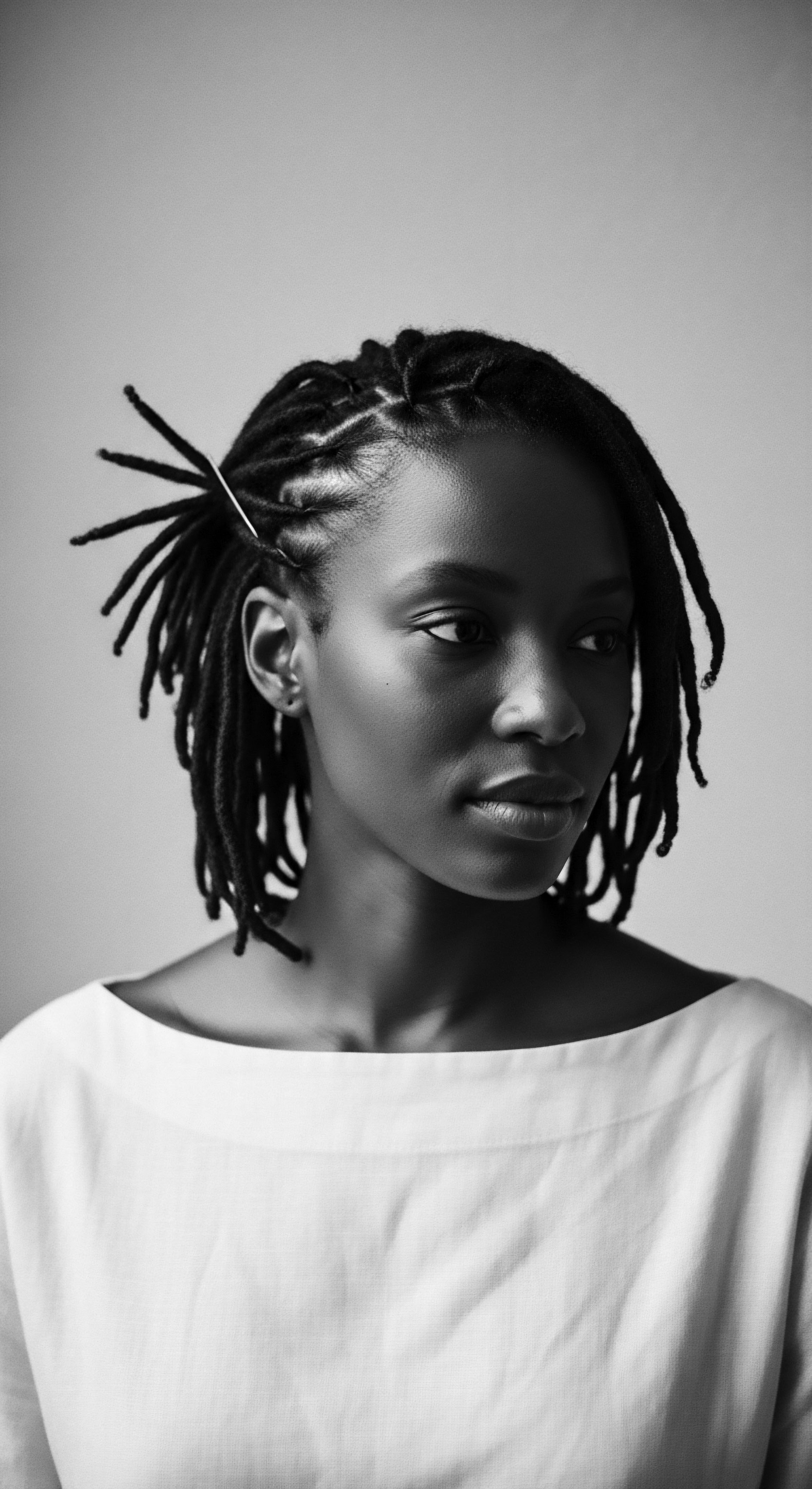
Fundamentals
The ritual of hair dyeing, often perceived in modern contexts through the prism of cosmetic transformation, possesses a lineage stretching back to the dawn of human adornment. At its simplest, the fundamental purpose involves altering the natural hue of hair strands, a process that transcends mere superficiality. This alteration, whether subtle or striking, has historically served as a profound form of self-expression, communal belonging, and spiritual communion across diverse cultures.
Hair itself, in many ancestral traditions, represents a living extension of one’s being, a conduit for energy, and a testament to generational wisdom. Its coloring, then, becomes a deliberate act of engagement with this vital aspect of self, infusing it with new meanings, or reaffirming old ones.
Early human societies, intimately connected with the rhythms of the earth, discovered that natural elements yielded potent pigments. From the crushed berries of the forest to the mineral-rich clays of riverbanks, ancestral hands learned to coax vibrant shades from their surroundings. This initial discovery was not an isolated act of vanity; it emerged from an understanding of the natural world, a keen observation of how plants and minerals stained the skin, the fabric, and, indeed, the hair.
The earliest forms of hair coloring were likely intertwined with protective practices, medicinal applications, or ceremonial preparations, where the chosen color held symbolic weight. The very concept of hair dyeing, therefore, began as an organic interplay between human ingenuity and the earth’s abundant palette, a dialogue that whispers through our current practices.
The fundamental nature of hair dyeing, far from being a modern caprice, is deeply rooted in ancestral human practices, entwining aesthetic alteration with expressions of identity, community, and spiritual connection.

Echoes from the Source ❉ Elemental Pigments and Early Adornment
Before synthetic compounds reshaped our palette, hair dyeing rituals were intrinsically linked to the immediate environment. Indigenous peoples, particularly those across the African continent, Asia, and the Americas, mastered the art of extracting vivid colors from their local flora and fauna. These botanical and mineral resources were not simply tools; they were sacred gifts, their properties understood through generations of observation and experimentation. The application of these dyes often followed meticulous processes, sometimes involving fermentation, heating, or specific lunar cycles, reflecting a deep reverence for the materials and the transformational power they bestowed upon the hair.
- Henna ❉ Derived from the dried leaves of the Lawsonia inermis plant, henna has been revered for millennia across North Africa, the Middle East, and South Asia. Its reddish-brown stain adorned hair, skin, and nails, signifying celebration, protection, and spiritual blessing. For communities with textured hair, henna also offered conditioning properties, sealing the cuticle and enhancing strand resilience.
- Indigo ❉ Sourced from the Indigofera tinctoria plant, this dye provided rich blue to black hues. Often used in conjunction with henna, particularly in parts of West Africa and India, it deepened tones, creating dramatic contrasts and signifying status or marital state. The meticulous preparation of indigo, often involving intricate fermentation, spoke to the dedication inherent in these ancient beauty rites.
- Ochre ❉ Various iron oxide clays, ranging from yellow to deep red, were extensively utilized by Southern African communities, including the San and Himba peoples. This earthy pigment, frequently blended with animal fats, provided both color and sun protection for hair. Its application was often a communal affair, symbolizing kinship, readiness for rites of passage, and connection to the ancestral lands.
The early exploration of hair color represented a profound scientific inquiry, albeit one rooted in empirical knowledge and generational transference rather than formalized laboratory settings. Knowledge of which plant yielded which hue, which mineral offered specific benefits, and how to best prepare these substances for optimal effect was passed down through oral traditions and embodied practices. The hair, in turn, became a living canvas, not merely for individual expression, but for the articulation of collective stories, affiliations, and spiritual beliefs.

Intermediate
The conceptualization of hair dyeing rituals, beyond their rudimentary application, blossoms into a complex interplay of personal identity and communal narrative. Within textured hair traditions, these rituals are not simple aesthetic choices; they represent an ongoing dialogue between the individual and their heritage, a vibrant testament to cultural continuity and adaptive beauty practices. The hair strand, with its unique structural characteristics, becomes a recipient of intent, carrying symbolic weight that can speak volumes about one’s lineage, social standing, or even spiritual state. This intermediate examination invites us to observe how historical methodologies, particularly within Black and mixed-race hair experiences, evolved from elemental knowledge into distinct cultural statements, embodying both resilience and profound artistry.
The historical trajectory of hair adornment within diasporic communities, particularly those of African descent, reveals a dynamic response to shifting social landscapes. Hair was, and continues to be, a potent signifier of freedom, defiance, or conformity. The choices regarding hair color, whether through traditional methods or new formulations, often mirrored broader societal movements and individual assertions of selfhood.
From the subtle red-gold tints achieved with native clays to the stark blackening with herbal concoctions, each choice was imbued with purpose. These practices often extended beyond mere visual appeal, carrying the weight of therapeutic intent, spiritual protection, or a declaration of cultural solidarity.
Moving beyond basic alteration, hair dyeing within textured hair traditions symbolizes a rich, complex interplay of identity, cultural continuity, and adaptive beauty practices.

The Tender Thread ❉ Living Traditions of Care and Community
Across the African continent and its diaspora, hair dyeing was frequently integrated into larger grooming rituals that fostered community and intergenerational bonding. These were not solitary acts performed in hurried moments. Rather, they were communal affairs, often involving meticulous preparation and patient application, frequently taking place within family compounds or village settings.
This collective engagement reinforced societal values and transmitted knowledge across generations. The hands that prepared the dyes, the fingers that massaged them into the scalp and strands, carried ancestral wisdom, transforming a cosmetic act into a profound experience of care.
Consider the intricate processes employed in certain West African communities, where powdered leaves or bark were mixed with specific oils or plant extracts. These mixtures were not only for color; they frequently possessed medicinal properties, addressing scalp health, strengthening hair, or offering protection from environmental elements. The act of dyeing thus became a holistic endeavor, tending to both the aesthetic and the physiological needs of the hair, affirming a philosophy where beauty and wellbeing were inseparable. The significance of this integrated approach offers vital lessons for contemporary hair care, reminding us that true adornment stems from a foundation of holistic care.
| Traditional Method/Source Henna (Lawsonia inermis) |
| Geographical/Cultural Context North Africa, Horn of Africa, Middle East, India |
| Purpose Beyond Aesthetics Conditioning, sun protection, spiritual blessing, marital status declaration. |
| Traditional Method/Source Ochre & Animal Fats |
| Geographical/Cultural Context Southern Africa (e.g. Himba, San) |
| Purpose Beyond Aesthetics Symbol of tribal identity, sun protection, insect repellent, rite of passage marker. |
| Traditional Method/Source Kola Nut / Camwood |
| Geographical/Cultural Context West & Central Africa (e.g. Igbo, Yoruba) |
| Purpose Beyond Aesthetics Deepening hair color, medicinal properties for scalp, spiritual significance in ceremonies. |
| Traditional Method/Source Walnut Husks (Juglans regia) |
| Geographical/Cultural Context Various (Europe, parts of Asia) |
| Purpose Beyond Aesthetics Darkening hair, sometimes used for natural scalp treatments; transported via trade. |
| Traditional Method/Source Indigo (Indigofera tinctoria) |
| Geographical/Cultural Context West Africa, India |
| Purpose Beyond Aesthetics Intense darkening for ceremonial purposes, signifying mourning or celebration; used in combination with other dyes for deeper shades. |
| Traditional Method/Source These ancient practices underscore a profound connection between hair, environment, and cultural meaning, where color served functions far exceeding simple visual alteration. |
The historical record, gleaned from archaeological findings and ethnographic accounts, paints a vibrant picture of these enduring customs. Hair dyeing practices were not static; they adapted over time, incorporating new ingredients introduced through trade or cultural exchange. The underlying principle, however, remained constant ❉ hair as a powerful medium for communication, capable of reflecting both personal spirit and collective memory. This enduring legacy prompts us to consider the present-day implications of hair color choices, recognizing them as continuing threads in a rich cultural heritage.

Academic
The academic investigation of Hair Dyeing Rituals transcends mere technical description; it delves into a nuanced exploration of symbolic meaning, socio-cultural construction, and the physiological engagement between human hair — particularly textured hair — and external chromatic agents. This meaning, in an academic sense, constitutes a complex phenomenon rooted in the intersection of biological anthropology, cultural studies, and the psychodynamics of identity. For Black and mixed-race communities, these rituals often serve as profound acts of self-definition, historical reclamation, and a visual grammar articulating belonging, dissent, or personal transformation.
The deliberate alteration of hair color, therefore, is understood not as a superficial act, but as a deeply embedded practice within a larger system of cultural signification, reflecting complex power dynamics, aesthetic values, and the enduring human desire for expression. It is a material manifestation of intangible heritage, a living archive inscribed upon the body.
The intricate relationship between the unique helical structure of textured hair and the molecular mechanisms of dyeing agents presents a compelling area for inquiry. The varied curl patterns, cuticle scales, and inherent porosity of Black and mixed-race hair strands significantly influence dye uptake, retention, and the resulting visual fidelity of the color. This bio-physical reality often necessitated distinct preparatory techniques and application methodologies within ancestral practices, demonstrating an intuitive, empirical understanding of hair science long before formal laboratories.
Modern trichological studies confirm that the elliptical cross-section and irregular distribution of melanin in textured hair require tailored approaches for optimal and healthy coloration, underscoring the inherited wisdom found in traditional care routines. This scientific validation of long-standing practices reinforces the notion that cultural knowledge often contains profound, albeit uncodified, scientific principles.

The Coded Chroma of Identity ❉ Sociopolitical Dimensions of Hair Dyeing
Within the broader discourse on appearance and identity, hair dyeing rituals in Black and mixed-race communities have frequently been entangled with sociopolitical narratives, particularly those concerning racial identity and colonial legacies. Hair, as a visible marker, became a site of both oppression and resistance. During periods of enslavement and subsequent racial discrimination, efforts to conform to Eurocentric beauty standards often influenced hair practices, sometimes leading to the suppression of traditional dyeing methods or the adoption of new ones aimed at achieving a lighter, more ‘acceptable’ aesthetic. Yet, simultaneously, acts of dyeing hair in traditional or defiant ways emerged as powerful assertions of cultural autonomy and rejection of imposed norms.
A powerful historical illustration of this deeply interwoven connection between hair dyeing, heritage, and identity comes from the Himba people of Namibia . Their distinctive practice of coating their skin and hair with ‘otjize,’ a mixture of butterfat, ochre pigment, and aromatic resin, is not merely cosmetic; it is a central pillar of their cultural identity, signifying wealth, beauty, and their profound connection to the earth and their ancestral spirits. The reddish-orange hue of the otjize-coated dreadlocks, meticulously crafted and maintained, differentiates them, marks their status, and embodies their spiritual state. As documented by anthropologists such as Margaret Jacobsohn, the daily ritual of applying otjize, often beginning in early childhood for girls, serves as a powerful means of cultural transmission, reinforcing social bonds and transmitting ancestral knowledge (Jacobsohn, 1996).
This deep, sustained, and communal engagement with an earth-derived hair coloring agent serves as a potent, less commonly cited example of how hair dyeing is not an isolated act but a fundamental, living ritual, inextricably linked to a people’s spiritual, social, and environmental heritage. The very act of coloring the hair with otjize embodies a comprehensive understanding of well-being, community, and the sacred.
The Himba people’s application of ‘otjize’ to their hair stands as a powerful testament to hair dyeing as a profound cultural ritual, embodying identity, status, and ancestral connection, far beyond superficial aesthetics.

Hair’s Structural Dialogues with Pigment ❉ A Scientific Understanding
The scientific comprehension of how dyes interact with textured hair mandates a keen appreciation of its microscopic architecture. Unlike straight hair, the elliptical cross-section of many textured hair types can lead to a more varied distribution of melanin granules within the cortex. Furthermore, the cuticle, the outermost protective layer of the hair, may have a more lifted or less evenly distributed pattern in certain curl configurations, potentially influencing the penetration and adherence of dye molecules. This intrinsic variability necessitates a sophisticated understanding of both the chemical composition of dyes and the physical characteristics of the hair receiving the color.
The process of permanent hair dyeing involves an oxidative reaction, where hydrogen peroxide acts as an oxidizing agent, breaking down the existing melanin and allowing new color molecules to form within the hair shaft. For textured hair, this chemical process requires careful management to mitigate potential moisture loss and protein degradation, which can compromise the hair’s structural integrity. The use of traditional conditioning agents—such as various plant oils, butters, or fermented preparations—alongside coloring agents in ancestral practices suggests an intuitive awareness of the need to protect and nourish the hair during transformative processes. This interplay of art, science, and reverence for the hair’s inherent characteristics defines a true understanding of hair dyeing rituals within a heritage-focused paradigm.
The socio-psychological ramifications of hair color choices within these communities are also ripe for academic scrutiny. The decision to embrace vibrant, non-traditional hues, to highlight natural grays, or to darken strands to a profound black can carry significant personal and collective meaning. Such choices might signify a rejection of assimilationist pressures, an affirmation of self-acceptance, or a deliberate reclaiming of autonomy over one’s body and image.
Research in cultural psychology and aesthetics often reveals that hair color, when chosen deliberately, functions as a powerful non-verbal communication, signaling affiliation, defiance, or personal journey. The deliberate coloring of hair, then, becomes a dynamic performance of identity, constantly evolving yet always rooted in a deep historical dialogue.

Reflection on the Heritage of Hair Dyeing Rituals
The enduring spirit of hair dyeing rituals, from their ancient origins to their contemporary expressions, represents a living continuum of human creativity, cultural identity, and profound connection to the self and community. This journey, especially when viewed through the unique experiences of textured hair and its diverse heritages, unfolds as a testament to resilience, adaptation, and an unwavering commitment to self-definition. The early applications of earth pigments, initially driven by necessity or spiritual belief, laid the groundwork for sophisticated practices that would, centuries later, confront colonial pressures and reclaim ancestral wisdom. The very strands that grow from our scalps carry not only our genetic code but also the indelible imprints of generations who cared for, adorned, and revered their hair as an extension of their very essence.
Today, as we stand at the crossroads of ancient wisdom and modern scientific understanding, the significance of hair dyeing transcends fleeting trends. It invites us to remember the hands that gathered the herbs, the communities that shared the knowledge, and the spirits that guided the rituals of transformation. For textured hair communities, coloring hair remains a vibrant act of reclamation, a powerful means of celebrating distinct beauty, and a continuous thread connecting past to present. It offers a tangible link to those who came before us, allowing us to participate in a timeless dialogue about identity, aesthetics, and wellbeing.
The vibrant pigments we choose today carry the echoes of ancestral whispers, urging us to recognize the profound lineage woven into every colored strand. The artistry of hair dyeing, therefore, is more than a technique; it is a heartfelt tribute to the enduring soul of a strand, ever blooming, ever rooted in heritage.
Hair dyeing, particularly within textured hair traditions, remains a living tribute to ancestral wisdom, a continuous dialogue of identity, and a profound act of self-definition that spans generations.

References
- Jacobsohn, Margaret. Traditional Hair and Head Adornments of Namibia. Gamsberg Macmillan, 1996.
- Sherrow, Victoria. Encyclopedia of Hair ❉ A Cultural History. Greenwood Press, 2006.
- Blay, Z. T. Yellow Fever ❉ A 500-Year History of Self-Hate and Love in Black America. HarperCollins, 2018.
- Byrd, Ayana, and Lori L. Tharps. Hair Story ❉ Untangling the Roots of Black Hair in America. St. Martin’s Griffin, 2014.
- Nichter, M. and M. Nichter. Cultural Contexts of Health, Illness, and Health Care. Waveland Press, 2008.
- Roberson, C. Hair ❉ The Great African American Hair Care Revolution. Health Communications, 2001.
- Banks, Ingrid. Hair Matters ❉ Beauty, Power, and Black Women’s Consciousness. New York University Press, 2000.
- Gittleson, Natalie. The Hair Commandments ❉ The Ultimate Guide to Frizz-Free, Beautiful Hair. Simon and Schuster, 2008.
